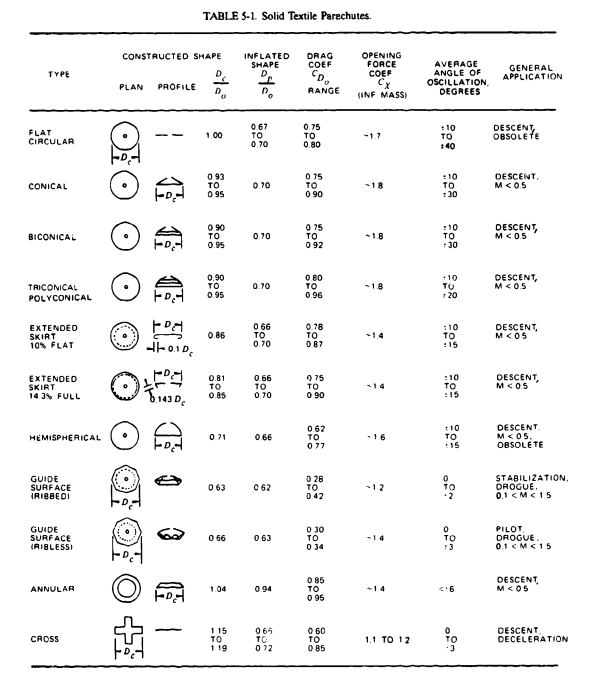Différences entre versions de « ENG-CANSAT-PARACHUTE »
| Ligne 21 : | Ligne 21 : | ||
* '''Velocity''' : between 8 m/s and 11 m/s (about 29 Km/H and 40 Km/H). | * '''Velocity''' : between 8 m/s and 11 m/s (about 29 Km/H and 40 Km/H). | ||
* '''Drag Coefficient''' : the [https://en.wikipedia.org/wiki/Drag_coefficient drag coefficient] depends on the parachute shape and the fluid used (''Air'' in this case). | * '''Drag Coefficient''' : the [https://en.wikipedia.org/wiki/Drag_coefficient drag coefficient] depends on the parachute shape and the fluid used (''Air'' in this case). | ||
| + | |||
| + | === Drag Coefficient === | ||
| + | * Semi Spherical Parachute : 1.5 | ||
| + | * Cross Shape Parachute : 0.8 | ||
| + | * Flat, Hexagone Parachute : 0.8 | ||
| + | |||
| + | [[Fichier:ENG-CANSAT-PARACHUTE-20.png]]<small><br />Source: [https://www.launchwithus.org/lwu-blog/2016/02/17/parachute-size-estimator-for-high-altitude-balloons Parachute Size Estimator]</small> | ||
== Resources == | == Resources == | ||
Version du 3 novembre 2018 à 23:17
Introduction
The CanSat use a parachute to slow it down when getting back to the earth. Otherwise the CanSat would crash!
The parachute is also used to maintain the CanSat in the proper position to properly orientate the antenna! This is essential to receive telemetry data.
The NAROM site in Norway did publish "The CanSat Book" containing lot of useful information.
The most interesting parts concerns the Parachute Design.
Parachute opening & tenseness
The process of parachute opening and air flow capturing is a violent process. The tenseness on the fabric, wire, hook may be really impressive at the opening.
So you need to select strong fibres and realise strong assemblies. The ideal materials are those used for human parachute (Nylon Cord, Ripstop Nylon).
Fundamentals parameters
The followings parameters are primary values to use when designing the CanSat's parachute.
- Mass : between 300gr and 350gr.
- Velocity : between 8 m/s and 11 m/s (about 29 Km/H and 40 Km/H).
- Drag Coefficient : the drag coefficient depends on the parachute shape and the fluid used (Air in this case).
Drag Coefficient
- Semi Spherical Parachute : 1.5
- Cross Shape Parachute : 0.8
- Flat, Hexagone Parachute : 0.8

Source: Parachute Size Estimator
Resources
- Parachute Design and Construction by Richard Nakka
- Parachute Size Estimator tool using imperial unit system (Launchwithus.org)
See this article which explains how to use it.
Written by Meurisse D. from MC Hobby - License: CC-SA-BY.